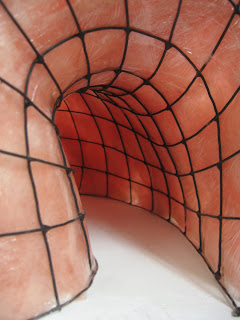Situation Destination, designed for the Charleston County Public Library, both conceptually and structurally, is the fourth piece in my ever-evolving body of large-scale site-specific installations, or “situations.” In my work I am very much concerned with surrounding spaces, and in cultivating, within these spaces, temporary experiences that engage the viewer on multiple levels.
Visually, I like to work with forms that are both interesting and appealing. The soft, undulating shapes tend to be biomorphic in design. Though they may resemble living organisms or forms found in nature, they are, at the same time, intentionally non-representational, leaving the viewer the freedom to make of it what he or she wishes. In contrast with the natural evocations of the form, the structure itself is constructed in a manner reminiscent of 3D computer graphics. Grid-like and rigid, it exposes the contrivance of the manmade, the fabricated environment.
I should note that I greatly dislike the term “viewer,” for my work is not designed simply for viewing. It is to be experienced, through active participation, which is why I much prefer to refer to such individuals as “participants,” “actors,” or just “the public.” So, in this sense, my pieces are physically stimulating, as well as visually, facilitating motion and movement throughout the carefully crafted space.
Several of the pieces that I have previously constructed have dealt with a physical notion of passage and happenstance. This “situation” that I have created for the library is more about destination. The library itself is a destination. You rarely just happen upon a library. Going to the library is a deliberate action, so for this piece I have endeavored to create a space that requires a similar activity. I anticipate that, perhaps initially out of curiosity, the public will make a decided choice to enter the installation, the “Situation Destination.” I like the idea that, if people respond positively upon their first encounter, this piece could also function as a destination to which to return. I see it acting as a haven of sorts. A place for folks to come and read, for children of all ages to come and hide out, a quiet escape, if only for a moment, from the commonplace.
Visually, I like to work with forms that are both interesting and appealing. The soft, undulating shapes tend to be biomorphic in design. Though they may resemble living organisms or forms found in nature, they are, at the same time, intentionally non-representational, leaving the viewer the freedom to make of it what he or she wishes. In contrast with the natural evocations of the form, the structure itself is constructed in a manner reminiscent of 3D computer graphics. Grid-like and rigid, it exposes the contrivance of the manmade, the fabricated environment.
I should note that I greatly dislike the term “viewer,” for my work is not designed simply for viewing. It is to be experienced, through active participation, which is why I much prefer to refer to such individuals as “participants,” “actors,” or just “the public.” So, in this sense, my pieces are physically stimulating, as well as visually, facilitating motion and movement throughout the carefully crafted space.
Several of the pieces that I have previously constructed have dealt with a physical notion of passage and happenstance. This “situation” that I have created for the library is more about destination. The library itself is a destination. You rarely just happen upon a library. Going to the library is a deliberate action, so for this piece I have endeavored to create a space that requires a similar activity. I anticipate that, perhaps initially out of curiosity, the public will make a decided choice to enter the installation, the “Situation Destination.” I like the idea that, if people respond positively upon their first encounter, this piece could also function as a destination to which to return. I see it acting as a haven of sorts. A place for folks to come and read, for children of all ages to come and hide out, a quiet escape, if only for a moment, from the commonplace.







